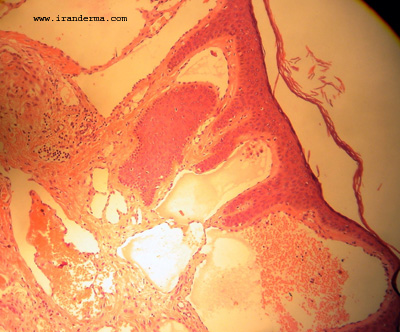IRANDERMA |
|
Quiz: January 2006 |
A 14-year-old girl presented with several years history for an asymptomatic lesion on her flank. She had not any other significant medical problem.
What is your diagnosis?

Diagnosis: Angiokeratoma (AK)
Comment by; M. Mehravaran, MD, Dermatologist/ Szeged, Hungary:
The
angiokeratomas are a group of benign vascular neoplasms in which
marked dilated, thin-walled vessels are situated beneath
hyperplastic and hyperkeratotic epidermis.
The Quiz
case is an Solitary Angikeratoma, which descibes by Imperial
and Helwig1
in 1967, this type of AK is a single small, bluish black, warty
papule which occurs predominantly on the lower extremities (Quiz
case is located in flank). It is not a hereditary lesions and
probably follows trauma, which subsequent telangiectasia prior to
formation of the AK. The mode of acquiring this lesions, the small
size, its solitary
nature, and its location distinguish it from the other forms of
angiokeratomas. It should be differentiate from seborrheic
keratosis, melanoma, pigmented basal cell carcinoma, pyogenic
granuloma and ordinary hemangima.
There are
several clinical types of angiokeratoma,
In
solitary AK,
there is well-circumscribed dark red, scaly papule of at least 0.5
mm diameter, which is often found on the leg.
Multiple
lesions of similar appearance can sometimes occur. Thrombosis of
superficial vessels of an AK cause the lesion to appear black,
simulating melanoma.
AK of
Mibelli
largely occurs as small multiple lesions on the skin of the dorsal
toes (and sometimes fingers) in patients with cold intolerance and
sometimes, perniosis.
AK of
Fordyce
affects scrotal or vulvar skin and, sometimes, that of the
adjacent abdomen or thight. This also features multiple lesions.
AK
corporis diffusum
is a component of several metabolic diseases, including Fabry's
disease (X-linked recessive alfa-galactosidase, A deficiency
disease that results in ceramide trihexidose accumulation in
several organs).
AK
circusmscriptum
is a rare condition in which a solitary plaque composed of contiguous
papular AK occupies a large area of skin.
Histopathology:
Sections
of all of the various AK shows a combination of thin-walled,
ectatic vascular spaces that contain erythrocytes and epidermal
hyperplasia with compact hyperkeratosis.
Differential
Dg:
Thrombosed
Aks are often so dark in color that they are suspected of being
melanoma. AK of Mebelli can sometimes be difficult to distinguish
from cryoglobulinemia or perniosis, but its lesions are more
sharply circumscribed. The epidermal changes of AK histologically
resemble those of verrucous hemangioma, a congenital lesion in
which vessels are present throughout the thickness of the dermis.
Treatment:
Solitary
AK are cured by simple excision. Multiple angiokeratoma can be
excisied, frozen, electrodesiccated, or treated with laser.
Refrences:
1.
Imerial R et al: Angiokeratoma. Arch
dermatol 1967,95:166.
ايران درما |
